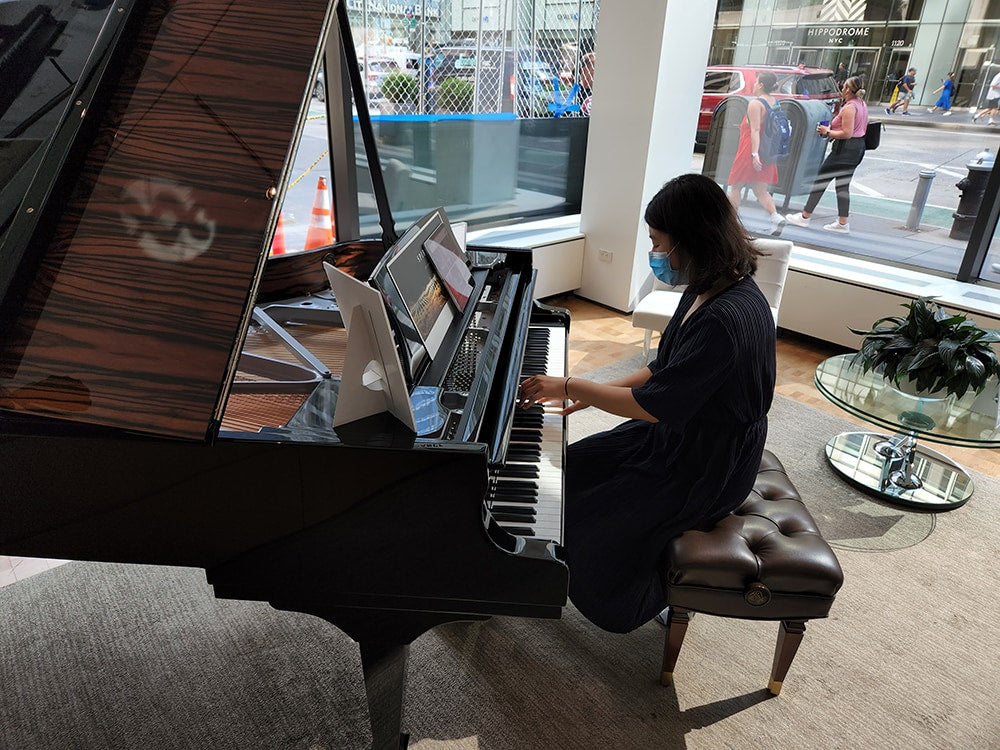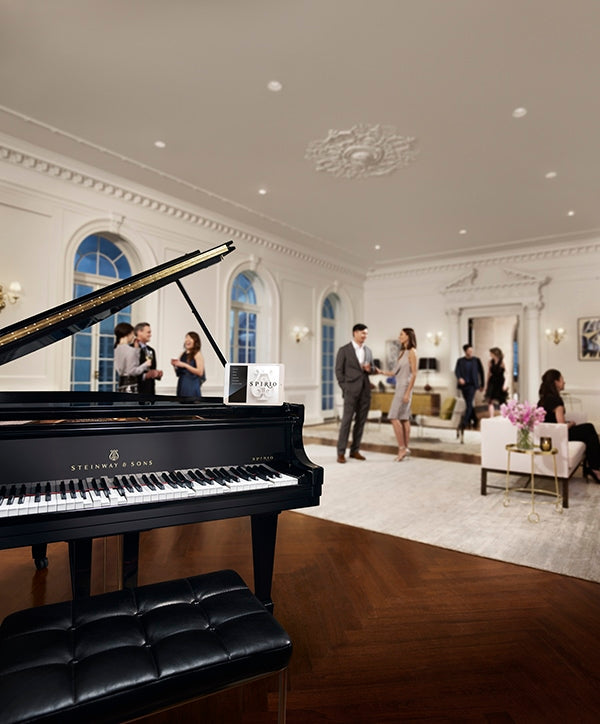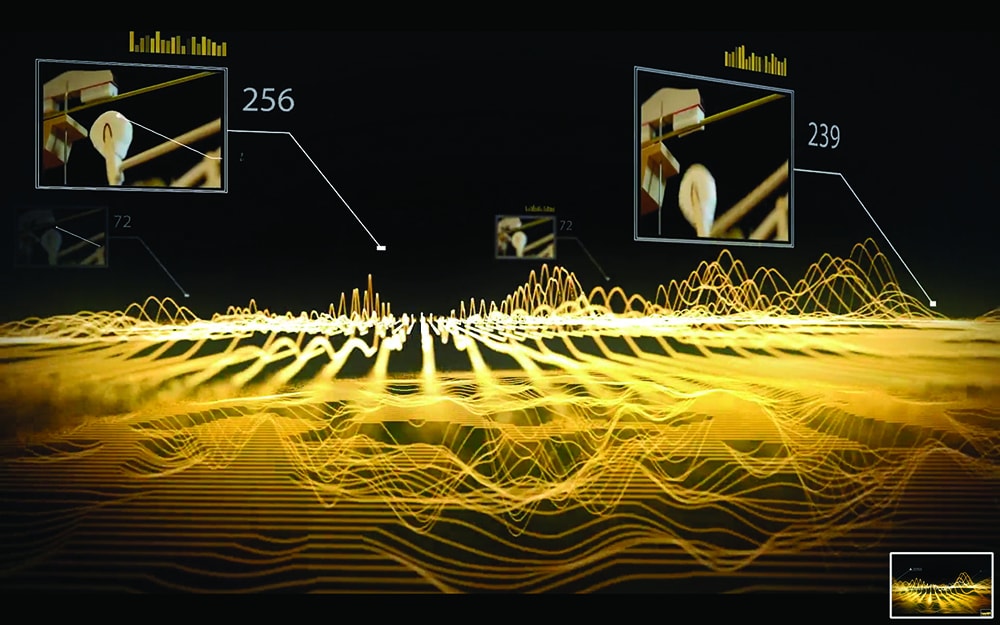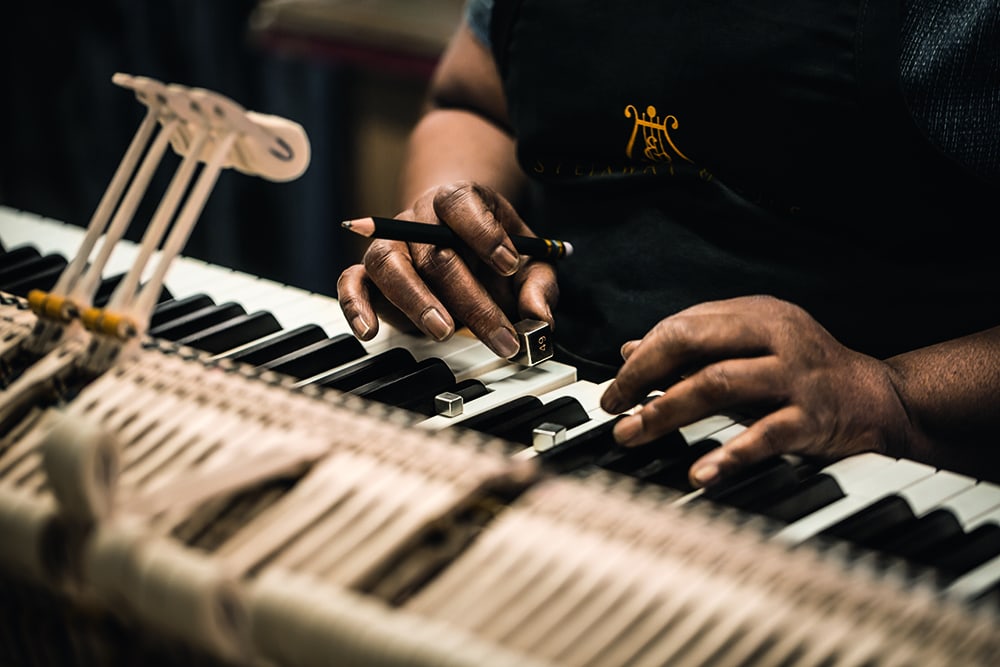A few months back, I was hanging out with Ed Gilmore at Gilmore’s Sound Advice auditioning the Steinway Lyngdorf Model D, a digital all-in-one system with powered speakers and a central processor to accommodate music sources and streaming audio. The high-gloss black polish, piano-like strings instead of grilles, and gold accents on the nearly 7-foot-tall floorstanding dipole speakers are evocative of a piano. The design is no accident as the Model D speaker, named after and tuned to the sound of Steinway’s largest concert grand, is a collaboration between Steinway & Sons and Lyngdorf Audio of Denmark. As an architect and A/V integrator, Gilmore places this fine system into luxurious homes where a $266,000 stereo fits in perfectly.
During our three-hour conversation about design, music, and Steinway, Ed asked if I knew about Spirio, a modified piano that plays music via an app. Wait, a player piano?! I’m old enough to remember those. An uncle of mine had an upright model that played a scroll of perforated paper that activated the keys as the roll unfurled. I couldn’t believe anyone wanted a player piano in the 1970s let alone now, but the burning question back then was, how many times could he listen to the player piano version of BJ Thomas’s “Raindrops Keep Fallin’ on My Head” (1969)? For me, it was once. I’m sure my uncle had others hidden in some closet when he had time to load and rewind rolls. But even that out-of-tune piano had a certain charm and was likely playing better than my uncle ever could – if he played at all. Hence, the reasons these pianos were so popular at one time.
The golden age of pianos spanned from the late 1800s through 1930. New York State alone had well over 100 piano manufacturers by 1910. New sheet music was being produced on Tin Pan Alley daily and hundreds of companies were in the piano roll business, recording music by budding legends Fats Waller, Eubie Blake, Scott Joplin, and Jelly Roll Morton. The piano was a central instrument in saloons, theaters, hotel lobbies, and homes, and Steinway & Sons was in the middle of it all. Founded by Heinrich Engelhard Steinweg in 1853 in Manhattan, Steinway & Sons made all types of pianos, including players, and managed to persevere through World Wars, the Great Depression, and the onset of recorded music and playback equipment. After 1930, the number of piano manufacturers dwindled to about a dozen worldwide.
When Ed Gilmore mentioned a 21st-century player piano, I was taken aback. I am a little protective of the brand, since I used to walk by Steinway Hall nearly every day when it was located on West 57th Street. I took my first lessons on a Steinway owned by Howard Lindsay, co-author of Sound of Music, admired Frank Sinatra’s personal Steinway in his room at the Waldorf Astoria (see my article in Issue 160), and even hit a few notes on an ornate gilded Steinway once owned by Judy Garland. I couldn’t suppress the image of cartoon robot arms in tuxedo sleeves springing out from beneath the keyboard, setting up a tip jar and running through “Raindrops Keep Fallin’ on My Head” – I watched a lot of television as a kid.
I wasn’t interested in the concept. If you want to own a piano, shouldn’t you play it or hire someone to do it? It’s almost like cheating. No serious musician or music lover would have a player piano in their home these days. That’s why we have expensive sound systems to play the exact track the way it was recorded at Lincoln Center or Carnegie Hall. Granted, it’s not exactly the sound of the piano, musician, or venue, but close enough is good enough.
Nevertheless, I kept thinking about Spirio and wanted to see and hear it for myself. I made an appointment at Steinway Hall, now on 43rd Street and Avenue of the Americas, and met with my knowledgeable host, Yahan Liu. In addition to being a sales associate, Ms. Liu, a graduate of Manhattan School of Music, is also a musician and teacher. She was the ideal person to show me what the Spirio could do.

Yahan Liu playing the Spirio. Courtesy of Tom Methans.
The showroom features traditional pianos on one side and on the other sits the Spirio r Model B, a full grand piano at 6 feet, 11 inches. Except for a power cord and discreet box of electronics under the case, the Spirio is like any other Steinway piano made in Astoria, Queens. There are no visible electronics or other mechanisms, just sensors within the piano measuring hammer velocity as well as force and speed gradations in pedaling. Solenoids engage the keys and pedals to replay music just as the artist performed it. Spirio’s control center is the complimentary iPad Pro with an interface similar to other streaming services that is searchable by artist, composition, and genre.
Not only does the Spirio r play music but it also records pieces, offering endless possibilities for musicians, students, and composers. An editing suite allows musicians to lay down tracks, analyze and adjust notes and passages, and even transcribe their pieces into sheet music or high-resolution audio files. It enables unparalleled collaboration. For example, a performer in New York can confer with their teacher in Asia, who can listen to the piece in different parts of a rehearsal hall from the audience member’s perspective. A composer and lyricist can work on a new Broadway show on opposite coasts, and a kid can take a music lesson without leaving home. Spirio can be integrated into an audio/video system for watching Steinway’s filmed performances, tutorials, and master classes.

The Spirio in action.
Steinway also stages Spiriocasts from Steinway Hall in New York and around the world, featuring live piano performances in your house by a large and continually growing list of Steinway Artists such as Olga Kern, Kristhyan Benitez, and Jenny Lin. But what if you wanted to hear a long-departed performer? Steinway has the “Steinway Immortals” with dozens of all-time greats, including Vladimir Horowitz, Glenn Gould, and Art Tatum. Gould caught my eye. His unique interpretations of J.S. Bach have always intrigued me, and now I could hear a snippet of the Goldberg Variations painstakingly dissected over weeks as another artist recreated music in the Gould style. That is the closest I will ever get to hearing Glenn Gould play live. Ms. Liu played a short passage to illustrate the mirror playback capabilities as keys and pedals came to life. I would have played something, but all those years of study were fruitless. I still love the piano’s sonorous, complex tones, and room-filling sound, and Ms. Liu made me realize that I really wanted a Spirio – and so do many others.

A representation of the Spirio’s proportional pedaling, where up to 256 gradations of pedal depth can be applied.
The Spirio has been in production since 2015 and demand exploded during COVID when its remote possibilities became apparent. Pricing starts at $114,000 for the smaller Model M, non-recording-capable Spirio in ebony. The Model B Spirio r I auditioned starts at $170,000, and for those with ample space, there’s also the Model D, which is the 8-foot 11-3/4-inch concert grand. Their prices might seem prohibitive, but the player category now accounts for almost 50 percent of Steinway piano sales, and models are currently on back order.
The idea of a piano that plays thousands of pieces with new ones added every month has changed my perception of a player piano. It might even encourage me to take lessons again, as playing music is said to keep older brains sharp. If that doesn’t work out, I can spend the rest of my days browsing the Steinway library for old and new musical gems. If I had a Spirio as a kid, I think I would have watched less television and practiced more Bach.
I was surprised to learn how many brands of modern player pianos were still in production. There are fully digital ones, digital/acoustic hybrids, and even aftermarket kits to convert conventional pianos, but kudos to Steinway for taking what is often a novelty piece relegated to a back room and elevating it to its highest potential. Add real-time broadcast concerts, an extensive catalog, and transfers of performances by historical musicians, and Spirio is a stroke of genius. Ultimately, Steinway’s quality, reputation, and partnerships with renowned artists and even Lyngdorf Audio have kept fine pianos on the musical landscape for 169 years and will likely do so well into the future. If I’ve piqued anyone’s interest, you can request a floor template to see which size Steinway fits in your room.

All images courtesy of Steinway & Sons unless otherwise identified.

0 comments